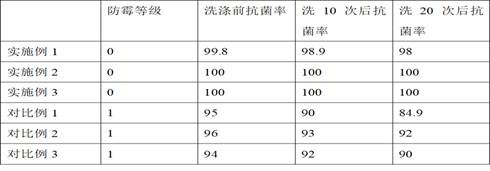Preparation method of antibacterial and mildew-proof agent for textiles
An antibacterial and antifungal agent and cross-linking agent technology, which can be used in botanical equipment and methods, fungicides, textiles and papermaking, etc. Improve effect time, improve binding performance, avoid elapsed effects
- Summary
- Abstract
- Description
- Claims
- Application Information
AI Technical Summary
Problems solved by technology
Method used
Image
Examples
preparation example Construction
[0028] A preparation method of an antibacterial and antifungal agent for textiles, the preparation method comprising the steps of:
[0029] (1) Mix the composite material and 0.3mol / L hydrochloric acid solution at a mass ratio of 1:10 to 15, maintain the pressure at 2MPa for 70s, steam explode, collect the blasting mixture, and mix the blasting mixture and water at a mass ratio of 3:5 Mix, heat to 100°C, cook for 5-7 hours, cool to room temperature, let stand for 20 minutes, filter, and collect the filtrate;
[0030] (2) Stir and mix the filtrate and activated carbon at a mass ratio of 7:1 to 3, let stand for 1 hour, filter, collect the filtrate, put the filtrate and ethanolamine into the reactor at a mass ratio of 16 to 18:1, and adjust the pH to Neutral, preheat at 50-55°C for 30 minutes, then add a catalyst with 0.1-0.2% ethanolamine mass, raise the temperature to 80-85°C, and stir at 600r / min for 8-10h;
[0031] (3) After the stirring is completed, cool to room temperatur...
Embodiment 1
[0034] The composite material is mixed with honeysuckle, litsea cubeba and Houttuynia cordata in a mass ratio of 10:5:7, and crushed to obtain the composite material.
[0035] The catalyst is a mixture of 1,1'-bisdiphenylphosphinoferrocene palladium dichloride and sodium methoxide at a mass ratio of 4:2.
[0036] The mixture is formed by mixing chitosan and ganoderma polysaccharide in a mass ratio of 20:1.
[0037] The mixed particles are formed by mixing nanoporous titanium dioxide and graphene oxide at a mass ratio of 9:1.
[0038] The crosslinking agent is a mixture of glutaraldehyde and genipin at a mass ratio of 13:1.
[0039] The surfactant is made by mixing polyoxyethylene sorbitan monooleate and sorbitan fatty acid ester at a mass ratio of 8:3.
[0040] A preparation method of an antibacterial and antifungal agent for textiles, the preparation method comprising the steps of:
[0041] (1) Mix the composite material and 0.3mol / L hydrochloric acid solution at a mass ra...
Embodiment 2
[0046] The compound material is mixed with honeysuckle, litsea cubeba and Houttuynia cordata in a mass ratio of 10:4:7, and crushed to obtain the compound material.
[0047] The catalyst is prepared by mixing 1,1'-bisdiphenylphosphinoferrocene palladium dichloride and sodium methoxide at a mass ratio of 4:1.5.
[0048] The mixture is formed by mixing chitosan and ganoderma polysaccharide in a mass ratio of 20:1.
[0049] The mixed particles are formed by mixing nanoporous titanium dioxide and graphene oxide at a mass ratio of 9:1.
[0050] The crosslinking agent is a mixture of glutaraldehyde and genipin at a mass ratio of 13:1.
[0051] The surfactant is made by mixing polyoxyethylene sorbitan monooleate and sorbitan fatty acid ester at a mass ratio of 8:3.
[0052] A preparation method of an antibacterial and antifungal agent for textiles, the preparation method comprising the steps of:
[0053] (1) Mix the composite material and 0.3mol / L hydrochloric acid solution at a mas...
PUM
 Login to View More
Login to View More Abstract
Description
Claims
Application Information
 Login to View More
Login to View More - R&D
- Intellectual Property
- Life Sciences
- Materials
- Tech Scout
- Unparalleled Data Quality
- Higher Quality Content
- 60% Fewer Hallucinations
Browse by: Latest US Patents, China's latest patents, Technical Efficacy Thesaurus, Application Domain, Technology Topic, Popular Technical Reports.
© 2025 PatSnap. All rights reserved.Legal|Privacy policy|Modern Slavery Act Transparency Statement|Sitemap|About US| Contact US: help@patsnap.com

